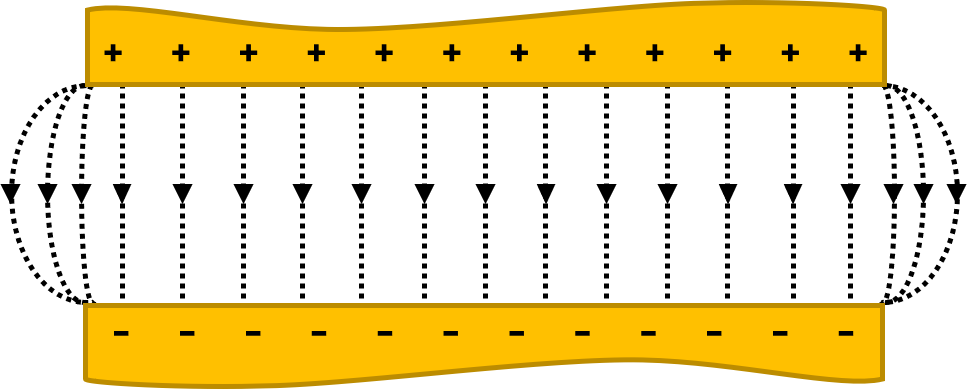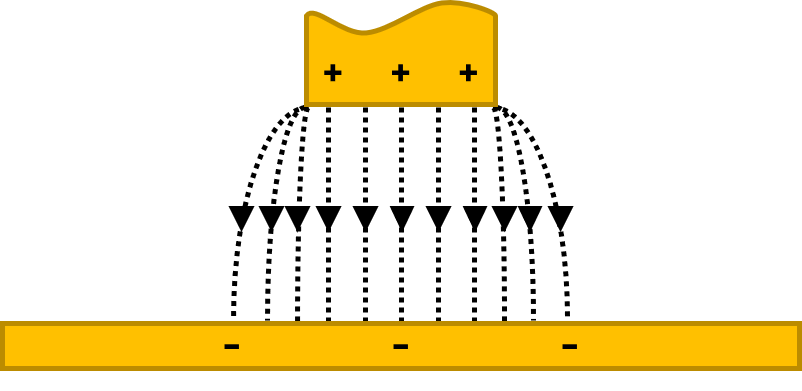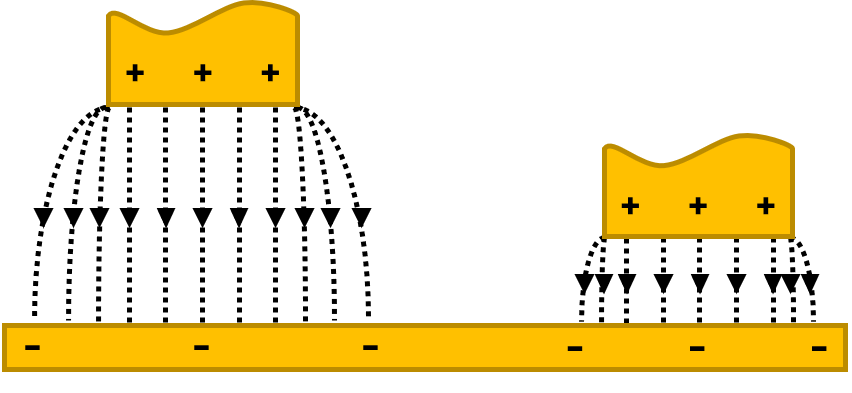SKP and the Fringing Effect
Latest updated: June 2, 2023Understanding the fringing effect and its role in Scanning Kelvin Probe (SKP)
Fringing is a phenomenon that occurs for capacitors of finite length. Between the two electrodes, a uniform electric field exists, however, at the edges of the electrodes the field becomes non-uniform and extends out into the surrounding space [1]. At this point, the electric field can be seen to bend beyond the edges of the electrodes. It is this extension of the electric field beyond the edges of the electrodes which is referred to as fringing [2]. Fringing at a parallel plate capacitor is illustrated in Fig. 1. Note this is a simplified illustration showing the fringing only of the parallel surfaces as would occur at the SKP probe where care is taken to stop the electric field at the sides of the probe.

Figure 1: The fringing effect between two electrodes of finite, and equal length is illustrated.
The dashed lines represent the electric field between the electrodes.
While Fig. 1 illustrates the fringing effect when the electrodes of a capacitor are equal, or similar, in length, this is not the case in SKP. In an SKP experiment, the capacitor electrodes are unequal in length, with the probe typically much smaller than the sample electrode, giving rise to a significant fringing effect as illustrated in Fig. 2 [3].

Figure 2: The fringing effect between two electrodes of finite, unequal length, as is the case for an
SKP probe and sample, is illustrated. The dashed lines represent the electric field between the electrodes.
The effect of fringing in SKP
Fringing can have a significant effect on the SKP measurement. The extension of the electric field beyond the edge of the plane of the SKP probe means regions beyond those directly below the probe tip will influence the signal measured in SKP. When the fringing effect is large, relative to the probe size, the lateral resolution of SKP can be reduced, and therefore efforts should be taken to minimize fringing for the highest quality measurements. With the decreasing distance between the capacitor electrodes, e.g. the probe and the sample, the fringe effect is reduced, Fig. 3 [1]. Therefore, working at the smallest practical probe to sample distance, typically 100 µm, and maintaining this distance throughout the measurement, reduces the fringe effect and improves the SKP measurement quality. The probe diameter is also known to influence the fringing in the SKP measurement. Smaller probe diameters are more susceptible to fringing effects than larger probes [4]. When working with SKP probes of small diameter it is important to keep in mind that the fringing effect can be detrimental to the lateral resolution possible from these probes. The final factor influencing the fringing effect on the probe is the sample uniformity. Samples with a high degree of non-uniformity, such as very rough samples, can result in a higher degree of fringing experienced by the probe [3].

Figure 3: The reduction in the fringing effect with the smaller probe to sample distances is illustrated.
Conclusion: understanding the effects of the fringing effect
The fringing effect is a phenomenon seen in capacitors, which influences the quality and lateral resolution of an SKP measurement. By understanding the influence of probe to sample distance, probe diameter, and sample inhomogeneity the fringing effect can be reduced and accounted for in experiments.
Further information on the factors influencing the SKP measurement can be found in our SKP101: Introduction to Scanning Kelvin Probe and Anatomy of an SKP Probe articles.*
References:
- Hegg, A. V. Mamishev, Conference Record of the 2004 IEEE International Symposium on Electrical Insulation (2004) 384-387
- J. Sloggett, N. G. Barton, S. J. Spencer, J. Phys. A: Math. Gen. 19 (1986) 2725-2736
- Subrahmanyam, C. Suresh Kumar, Kelvin Probe for Surface Engineering: Fundamentals and Design, Ane Books Pvt. Ltd., New Delhi, (2009) 45
- Wicinski, W. Burgstaller, A. W. Hassel, Corros. Sci. 104 (2016) 1-8
More on SKP...
Related products